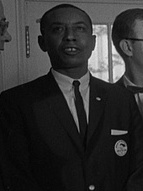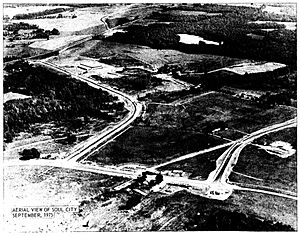Floyd McKissick facts for kids
Quick facts for kids
Floyd McKissick
|
|
|---|---|

McKissick in 1963
|
|
| 2nd National Director of the Congress of Racial Equality | |
| In office 1966–1968 |
|
| Preceded by | James Farmer |
| Succeeded by | Wilfred Ussery |
| Personal details | |
| Born | March 9, 1922 Asheville, North Carolina |
| Died | April 28, 1991 (aged 69) Soul City, North Carolina |
| Spouse | Evelyn Williams |
| Children | Floyd McKissick Jr. Joycelyn Andree Charmaine |
| Alma mater | Morehouse College |
Floyd Bixler McKissick (March 9, 1922 – April 28, 1991) was an American lawyer and a very important leader in the civil rights movement. He made history by becoming the first African-American student at the University of North Carolina School of Law.
In 1966, he became the head of CORE, a major civil rights group. He took over from James Farmer. McKissick believed in Black Power, which meant Black people should have more control over their own lives and communities. He helped make CORE a stronger, more active group. Later, in 1968, McKissick started a new community called Soul City in Warren County, North Carolina. He also became a state judge in 1990. His son, Floyd McKissick Jr., also became a politician and lawyer.
Contents
Early Life and Education
Floyd Bixler McKissick Sr. was born in Asheville, North Carolina. He started working for civil rights when he was just 12 years old, by joining the NAACP. This group works to protect the rights of Black people.
When he was 13, a white police officer pushed him down. This unfair treatment made him even more determined to fight for civil rights. He said he was active in politics from when he was about 16 or 17. One of his first protests was in Asheville because the city wouldn't let actor Paul Robeson speak there.
After finishing high school in 1939, he went to Morehouse College in Atlanta in 1940. During World War II, he served as a sergeant in the U.S. Army in Europe. After the war, he returned to Morehouse College and graduated in 1948.
Early Protests and Political Work
McKissick was part of an early "freedom ride" in 1947. This ride challenged unfair rules that separated people by race on buses and trains traveling between states. He was also involved in helping people register to vote. He supported Henry A. Wallace in his 1948 presidential campaign.
In 1957, McKissick helped organize a boycott of the Royal Ice Cream Parlor in Durham, North Carolina. This was because the parlor refused to serve Black customers. He led 20 high school students from the NAACP who picketed outside the business regularly.
Breaking Barriers at UNC Law School
After college, McKissick wanted to become a lawyer. He applied to the University of North Carolina School of Law but was not accepted because he was Black. He then enrolled at North Carolina College (now North Carolina Central University) in Durham, which was a law school for Black students.
The NAACP took on his case and sued the University of North Carolina. Thurgood Marshall, who later became a Supreme Court Justice, helped lead the legal team. In 1951, a court ruled that McKissick and three other Black students could attend UNC's School of Law. Even though he was almost done with his degree at NCC, he took classes at UNC that summer. He was among the first Black students to be admitted to UNC Law School.
McKissick's Legal Work
In 1955, McKissick opened his own law firm in Durham, North Carolina. His firm focused on civil rights cases. He represented the first Black undergraduate students who attended UNC-Chapel Hill in 1955.
He also successfully defended students who protested unfair rules at Durham's Royal Ice Cream Parlor in 1957. In 1959, he helped families who wanted to integrate Durham's city schools. His own daughter, Joycelyn, and his wife, Evelyn, were lead plaintiffs in that important school case.
Leading CORE

After the famous sit-in at Woolworth's lunch counter in Greensboro in 1960, CORE sent people to help organize more protests. McKissick met CORE leaders and helped organize demonstrations in Durham. He handled legal issues for both the NAACP and CORE. Eventually, he focused only on CORE. In 1963, he was elected to a national leadership role in CORE.
On January 3, 1966, Floyd McKissick became the national director of CORE, taking over from James Farmer. Under McKissick, CORE changed. It became a group that strongly supported "Black Power." This idea meant that Black people should have more control over their own lives and communities.
In 1966, James Meredith started a march to protest unfair treatment. McKissick, along with Martin Luther King Jr. and Stokely Carmichael, helped lead the marchers for the last 194 miles to Jackson, Mississippi. McKissick said they brought all the civil rights groups together to continue the march.
McKissick left CORE in 1968, and Roy Innis took over as the new leader.
Creating Soul City

After leaving CORE, McKissick started a big project to build a new town called Soul City. This town was planned for 500 acres of farmland in Warren County, North Carolina. McKissick had thought about this idea since after World War II. He wanted Soul City to help stop Black people and poor people from leaving rural areas for crowded cities. It was meant to be a town for everyone, but especially to create opportunities for minorities and the poor.
The project received a lot of money. The U.S. government helped with a $14 million guarantee. They also got a loan from a bank and money from the state of North Carolina and private donors. With this money, McKissick built a modern water system, a health clinic, and a large factory called Soultech I. The plan was for Soul City to have 24,000 jobs and 44,000 people by the year 2004.
However, Soul City faced many problems and did not grow as McKissick had hoped. In 1980, the project ended its agreement with the federal government. The government took control of most of the land. McKissick's company kept some land, including a mobile home park and the project's main building.
Later Life and Death
In June 1990, Floyd McKissick was appointed a state district court judge in North Carolina. He was also a pastor at the First Baptist Church of Soul City. Less than a year after becoming a judge, he passed away from lung cancer on April 28, 1991, at the age of 69. He was buried in Soul City. He was survived by his wife, Evelyn, and his four children: Floyd Jr., Joycelyn, Andree, and Charmaine.
Images for kids
-
Civil rights leaders meeting with President John F. Kennedy in 1963. McKissick stands at the far left.
-
Soul City, 1975




